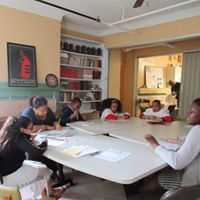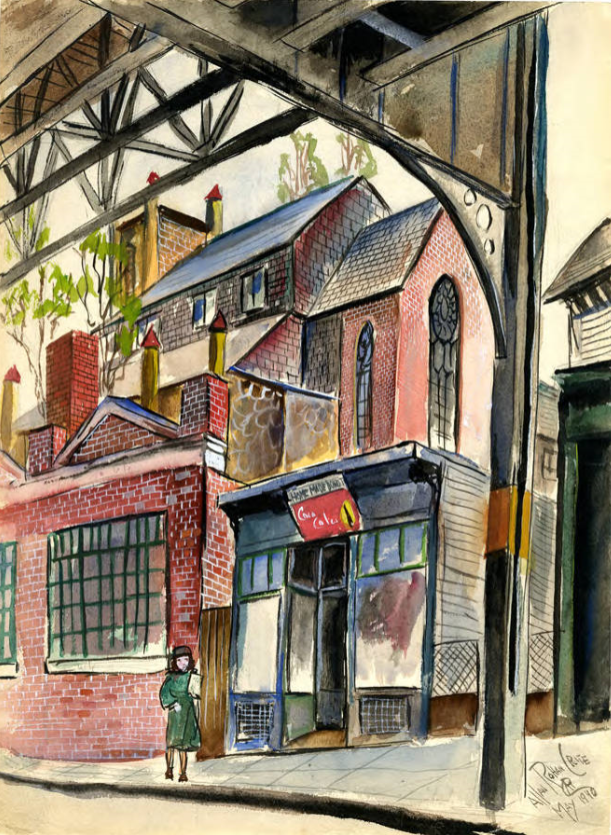Church History

A Sunday School class in the Ming Room, at St. John St. James, 2018.
St. John St. James was created in the 1960s as a merger of two congregations, St. John's and St. James. The newly created church moved into 149 Roxbury Street and found a role in serving the Roxbury neighborhood through a variety of ministries and served as a home for seminary students and community activists who were drawn to its ministry. St. John St. James is a diverse church community, with members whose roots are from Barbados, Costa Rica, El Salvador, Haiti, Honduras, Jamaica, Trinidad, Canada and the United States.
St. John St. James Church has roots in two Roxbury churches: St. James, organized in 1832, and St. Johnís which was created as a mission of St. James and became a parish in 1872. The following history is from the official history/profiles published by the diocese. Additional articles about the church's history are found on our ARTICLES page.
St. James Episcopal Church. The first Episcopal church in Roxbury, St. James, was organized in August 1832. In the nineteenth century, St. Jamesís became a parish for many affluent Boston families whose summer homes brought them to what was called the Boston Highlands. The parish developed a strong missionary tradition, and from St. Jamesís came St. Johnís Church in Jamaica Plain, St. Anneís Church in Dorchester (now closed), and St. Johnís Church in Roxbury.

St. James Episcopal Church, by Allan R. Crite, 1940. View from Washington Street under the elevated orange line tracks. Used with permission from Boston Athenaeum.
In April 1859 the Reverend George Sherman Converse was called from the Church of the Ascension, New York, to become rector, and with him came the vitalizing influence of the Catholic movement. The church, built about 1834, and attributed to architect Richard Upjohn, was renovated, and a vested choir was introduced. Dr. Converse was concerned with all his parishioners, rich and poor, and manifested his catholicism in a missionary spirit that brought him into contact with the working-class population of Roxbury.
St. John's Episcopal Church. In 1861 Reverend Converse began missionary services in a hall on Tremont Street. By 1866 a Sunday school and sewing classes were flourishing, and plans were made for a chapel in the area known as Roxbury Crossing. The congregation organized as St. Johnís Parish in 1872, and the following year parishioners called Dr. Converse from St. Jamesís to the rectorate to the new church. During his twenty-two years at St. Johnís, he served as chairman and member of the Diocesan Standing Committee, and was appointed the first archdeacon of Boston in 1894.
A conscious effort was made by Dr. Converse and his successors to draw new members to Episcopal services by offering the liturgy and ritual of Anglo-Catholicism. St. Johnís increasingly became a church with a mission to the poor of lower Roxbury, many of whom were African Americans who had migrated from the South End of Boston. Under the Reverend Frederic W. Fitts (rector 1908-1945), an associate member of the Society of St. John the Evangelist, the traditional Anglican ceremonial of the Sarum Rite was developed. (Father Fitts also was chairman of the Diocesan Department of Religious Education from 1918 to 1928. ) He saw in the sacraments of the church the opportunity for constant instruction of the young and old of the parish in Catholic doctrine and principles. He introduced the opportunity for confession and developed the churchís healing ministry in general. Always, there was an attempt both to evangelize and to involve the laity. At the parishís fiftieth anniversary, Bishop William Lawrence spoke of the parishís unique place in the diocese:
"St. Johnís has been the church of the people Ė of all the people. All ranks, social and financial, have worshipped here in Christian brotherhood. We have here an example of true Christian democracy. Every one of the rectors of St. Johnís has held to the tradition of its founders, of a real parish with a real pastor."
With the death of Father Fitts in 1945, St. Johnís lost one of the churchís great pastors. His successor, the Reverend Warren H. McKenna from St. Peterís Church in Jamaica Plain, saw the need for broadening the pastoral function of the church, "to be the outward and visible means of leading mature people to embrace the full Gospel of Our Lord and Saviour, and then to manifest that Gospel in the fields of social action on the political and economic level."
1960s and St. John St. James merger. Father McKennaís prophetic words found their fullest expression in the 1960s. Midweek Holy Eucharists were held in private homes, and St. Johnís became increasingly involved in its community. Under the noteworthy leadership of the Reverend Gilbert S. Avery (1960-1966), not only did the parish grow, it became a leading advocate for the community in the areas of housing and upgrading of the schools.

A church bulletin from St. John's from 1967 lists the Information and Referral Center. Parish letters and bulletins from this time period mention a wide range of parish activities.

St. Luke's Chapel, shown here, and Ionic Hall, with the 1960s addition, make up the St. John St. James complex at 149 Roxbury St.
The St. James church building was sold to the city as part of urban renewal in 1962, with parishioners meeting in a storefront in the years that followed. In 1967, the St. John's church building was also sold in the wake of the planned (later canceled) highway expansion plans. The church was seriously damaged by fire in April 1967.
After a year of storefront services, both congregations came to recognize the value of combining their resources. In 1968 the parishes reunited as St. John St. James Church, purchasing the site of the former St. Lukeís Home for Convalescents. Father D'Onofrio was joined by Father James Mitchell, formerly on the staff of St. James. For two years the congregation worshiped in the historic St. Luke's Chapel built ca. 1901, designed by architect Ralph Adams Cram. On September 20, 1970 a new worship space was consecrated by Bishop John M. Burgess, the first African American diocesan bishop in the United States. Designed by Architects Design Group of Cambridge, this space was added to the rear of Ionic Hall (ca. 1802), which continued to serve as office space, parish hall, and residence for staff and seminarians.
Continuing the tradition of involvement, the new parish established in October 1968 the Parents for Justice and Welfare Rights, Inc., a group of public-assistance recipients who work to see that recipients receive a fair share, as well as the respect due any human being. Other projects, such as the St. Johnís St. James Community Clinical Nursery School, the Conscientious Objectors Program, the St. Jamesís Tutorial Program, and courses in reading and black history, made St. John St. Jamesís a home, a church, and a community.
In recent years, St. John St. James has been led by Rectors and Priests-in-Charge, Rev. Cornelius Hastie, Rev. Jean Baptiste Ntagengwa, Rev. Gift Makwasha Muendamberi, and currently Rev. Rospignac Ambroise.
Father Hastie's ministry with St. John St. James began with the two original churches. He served at St. John's as a seminarian, at St. James during the 1960s. He then served in other parishes and was later called to St. John St. James where he led for many years. Fr. Hastie died on June 15, 2016 at the age of 85.
Father Gift now is Priest, Dean, and Chaplain at Bishop Gaul Arundel Girls School in the Diocese of Harare (CPCA).
The Rev. Jean Baptiste Ntagengwa, Th.D is now Canon for Immigration and Multicultural Ministries for the Episcopal Diocese of Massachusetts, and continues his connection with St. John St. James through that role.
Under the leadership of Fr. Ambroise, St. John St. James has an ongoing relationship with a Haitian congregation in Everett, continuing the tradition of multi-cultural ministry. St. John St. James continues the tradition of reading the gospel in French, Spanish and English, a tradition that reflects the cultural roots of church members.
Read more church history and current projects through our series of ARTICLES.
